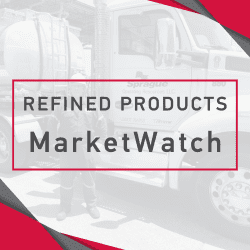Recap: Oil futures extended gains on Wednesday, with both WTI and Brent reaching their highest level in eight months. Traders shrugged off an API report showing a 3.8 million barrel build in U.S. crude oil stockpiles and instead focused more on the 0.8 million barrel decrease as reported by the EIA and on reports regarding a vaccine for COVID-19. Weakness in the U.S. dollar also added support. January WTI traded above $46 a barrel to reach a session high of $46.26 before trimming gains for a settlement of $45.71 a barrel, up .80 cents, or 1.8%. Brent for January delivery added 75 cents, or 1.6%, to settle at $48.61 a barrel. December RBOB was at $1.2875 a gallon, up .0293 cents, while December heating oil added .0271 cents, to settle at $1.3866 a gallon.
Technical Analysis: Despite the higher climb, demand still remains the main issue and with U.S. gasoline inventories building 2.2 million barrels, it doesn’t look like demand is picking up. The increase in gasoline inventories shows that demand for gasoline remains under pressure, and it’s hard to expect material improvements on this front in the coming weeks due to the situation with the coronavirus. This, combined with crude oil in the $45 range, may prompt U.S. producers to ramp up volume if the market hovers around this level, which would add more barrels to an already saturated market. At this point, it is more of a waiting game. Support is seen at $43.71 and below that at $42.86. A break below this level allows for a stretch toward $42.. To the upside resistance is set at $6.30 and above that at $47.30.
Fundamental News: Baker Hughes reported that the number of oil and natural gas rigs increased by 10 to 320 in the week ending November 25th. The number of rigs searching for oil increased by 10 to 241 in the week ending November 25th. It reported that drillers added oil and natural gas rigs for the fourth consecutive month.
Three sources close to OPEC+ said OPEC and allies, including Russia, are leaning towards delaying next year’s planned increase in oil output to support the market during the second wave of COVID-19 and increasing Libyan output. OPEC+ is due to increase its output by 2 million bpd in January.
IIR Energy reported that U.S. oil refiners are expected to shut in 3.7 million bpd of capacity offline in the week ending November 27th, increasing available refining capacity by about 211,000 bpd from the previous week.
The U.S. Labor Department reported that the number of initial claims for unemployment benefits increased further last week, suggesting that an explosion in new COVID-19 infections and business restrictions were increasing layoffs and undermining the labor market recovery. Initial claims for state unemployment benefits totaled a seasonally adjusted 778,000 in the week ending November 21st, compared with 748,000 in the prior week.
The U.S. Commerce Department confirmed the economy's historic pace of expansion in the third quarter. It reported that gross domestic product grew at an unrevised 33.1% annualized rate. The economy contracted at a 31.4% rate in the second quarter, the deepest since the government started keeping records in 1947. The Commerce Department reported that consumer spending increased by 40.6% in the third quarter. Consumer spending in October increased 0.5% after increasing 1.2% in September. Personal income fell by 0.7% in October, reversing a 0.7% gain in September. The U.S. personal savings rate was 13.6% in October, down from 14.6% in September.
The U.S. Commerce Department reported that orders for non-defense capital goods excluding aircraft, a closely watched proxy for business spending plans, increased 0.7% in October. Orders for durable goods, increased 1.3% in October after increasing by 2.1% in September.
Early Market Call – as of 8:45 AM EDT
WTI – Jan $45.39, down 14 cents
RBOB – Dec $1.2675, down 1.45 cents
HO – Dec $1.3675, down 1.3 cents










